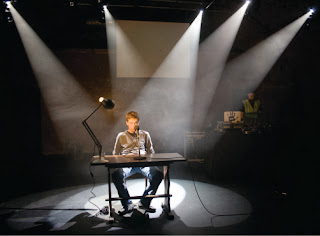'Beats' review or 'I just can't control my beat!'
‘Beats’, Kieran Hurley
Soho Theatre, Tuesday 15th October 2013
Young Johnno has taken a pill
and the dance music is starting to take over his body. Here is how Kieran
Hurley - one of the most gifted and poetical playwrights of his generation – describes
this moment:
And without even noticing the music finds a flow through him, speaking
straight to his body. Like it’s flowing through him but like he’s immersed in
it at the same time, engulfing him in its immediacy, in its intimacy.
It’s a superb description of
Johnno’s high – but this quotation also captures everything that is brilliant
about Kieran Hurley’s latest play, ‘Beats’. This show will wriggle inside you
like the deepest of dance beats, shuddering through your system. It is a stunning
piece of theatre; immersive, exhilarating and utterly convincing.
There are only two performers
in this production; Hurley, who recites and performs his play, and an on-stage
DJ. A video artist also works back-stage and ensures that a large on-stage screen
blazes constantly with psychedelic images. These three performers work
instinctively together to create one of the most finely textured and dynamic
shows I’ve seen. The images, music and script tumble into each other and bring
out the most vibrant colours, characters and feelings.
Layered on top of all of this
is the exquisite rhythms contained in Hurley’s script. This man is a poet. On
one level, it shouldn’t surprise that this piece revolves around rhythm. After
all, ‘Beats’ focuses on a Scottish teenage who, bored of playing Zelda in his
bedroom, decides to sneak off to an illicit 90s rave with his friend. It’ll be
one of the last of its kind since the government stands on the verge of
outlawing all public raves. This is a play about music and the sway it holds,
the hope, euphoria, understanding and connections it can create. But this play
doesn’t just talk about music. It is music.
Hurley creeps into his
characters heads and carefully extracts their defining rhythms. He even
extracts the rhythms of the roads, the landscapes, the past and the future.
Trapped alone in his room, with only a computer game for company – young Johnno,
or at least the verse that describes young Johnno, is steady, repetitive and searching;
‘He sits in his bedroom, his bedroom/looking out the window at the
dreich/evening, the orange sulphur street, the row of hedges,/the bitumen
pavements, the dog shit.’
Johnno’s rhythms morph subtly
as the night progresses. We experience the jittery excitement of the car-ride
to the rave (‘Shut. The Fuck. Up!’), the stretched expanses of the landscape
beyond the car window (‘And he imagines it as the living pulse of the tarmac,
and the electricity pylons that flick past his eyes keeping time.’), the rush
and swell of the drugs (‘All of us, he thinks. All of us together holding on,
clinging on for dear life!’) and the frozen and juddering fear of the car-ride
home with his frightened, angry mother.
There are endless subtleties
within these major rhythm shifts. The music and images sometimes work with the
rhythms of the speech, amplifying the beats and ideas (We see a picture of
Ranvescraig Steelworks come tumbling to the ground, as a policeman fights with
his dad about the future of Scotland). At other times, these images work
against the words, tugging at their meaning and tussling with the ambiguities
of language and perspective. And then there are the other characters: Johnno’s
bickering friends, the surging crowd, the policeman who pops in and out of the
play, haunted by his father and hunted down by a future he cannot reach.
Finally, there is Johnno’s
mother. Her speech is mainly composed of lists of worry; ‘Dogging school?
Probably. Tick. Fighting? Possibly. Tick. Drinking? Seemingly. Tick.’ These
worries are amplified by the image of clock, tick tick ticking on the back wall.
The music stops when the mother speaks and the only thing left in her world is
the tick of the clock and her worries about her son.
Hurley’s script slides between
these characters’ heads and we glide from fear to joy, depression, confusion,
anger, despair and love. Hurley’s play allows us to channel these emotions
easily and deeply; it’s as if the play is one great album, each character with his
or her own hit track. The content and the message fuse brilliantly and it
becomes impossible to tell when the music stops – and the soul begins.



Comments
Post a Comment